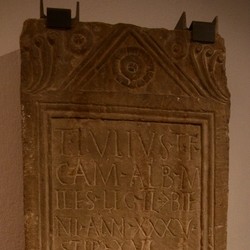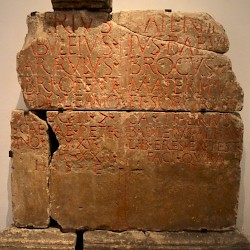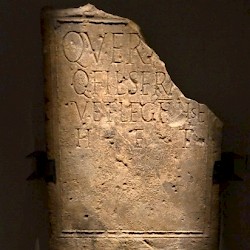Legio II Augusta
Legio II Augusta: one of the Roman legions. Its name means "the legion of Augustus", but contains a pun on "august legion".
Origin

This legion may have been recruited by consul Gaius Vibius Pansa and Octavian (the later emperor Augustus) in 43 BCE and was called Sabina ("from the Sabine country"). If this is correct, it first fought against Mark Antony on the eastern plains of the Po, and later, when Mark Antony, Octavian and Lepidus had allied themselves in the Second Triumvirate, against the murderers of Julius Caesar, Cassius and Brutus, in the battle of Philippi (42). A sling stone perhaps mentioning Caesar Leg II seems to prove that the Second was present at Perugia in 41, where Octavian besieged Mark Antony's brother Lucius.
The Second Sabine legion legion may be identical to the Second legion Gallica; if so, this is a clue to its location in the years before 30 - in Gaul. The settlement of veterans at Orange may confirm this.
Spain
After 30, it was stationed at an unknown place in the north of Hispania Tarraconensis and took part in Augustus' campaigns against the Cantabrians, which lasted from 25-13 BCE. This was a very large war: among the other troops involved were I Germanica, IIII Macedonica, V Alaudae, VI Victrix, VIIII Hispana, X Gemina, XX Valeria Victrix, and another legion, perhaps VIII Augusta. In these years, the Second legion and I Germanica were involved in the building of the colonia Acci in Spain. Veterans were settled in Barcelona and Cartenna (in Mauretania).

II Augusta was probably moved to the Rhine after the Roman defeat in the Teutoburg Forest (September 9 CE). It was stationed somewhere in the neighborhood of Mainz. From here, it marched into "free" Germania, during the campaigns of Germanicus (14-16). Together with the Fourteenth legion Gemina, it is mentioned as one of the units that was threatened by a sudden flood during a naval campaign on the Wadden Sea.
Strasbourg
After Germanicus had been recalled, the legion received a new base at Argentoratum (modern Strasbourg) in Germania Superior, where the legion protected a strategic crossing point of the Rhine.
In 21, the Second was involved in a military action against two Gallic rebels named Julius Sacrovir and Julius Florus, which had affected large parts of Gaul. This victory was commemorated with a triumphal arch in Orange.
Britain
In 43, the emperor Claudius invaded Britain with II Augusta, VIIII Hispana, XIV Gemina and XX Valeria Victrix; the commander of the Second was Titus Flavius Vespasianus, the future emperor Vespasian. It was stationed first in Silchester and after 49 in Dorchester and/of Lake Farm. In 55, however, the legionary base at Exteter was built and the legion was again concentrated on one place. Nineteen years later, it moved to Gloucester.

The legion's behavior during the revolt of queen Boudicca remains unexplained. When governor Suetonius Postumius asked for help, the prefect of the camp, a man named Poenius Postumius, ignored this request (and later committed suicide). Its unclear why there was no legate (commander) who could make the decision.
In the civil war of the year 69, a part of II Augusta sided with the emperor Vitellius. At least one subunit took part in his march on Rome, and fought in the battle at Cremona against the legions of Otho. Later, these soldiers were defeated by those of Vespasian, and returned to Britain in 70. It is possible that the main body of the legion had always been loyal towards Vespasian.

During the reign of Vespasian, II Augusta was still in Britain, although it was transferred to Caerleon in Wales in 75. When Gnaeus Julius Agricola was governor of Britain (77-83), it remained in Caerleon, as a strategic reserve in Wales and England. It was only in 139 that it was on the move again: soldiers of II Augusta were working in Scotland, building the Antonine wall (between Edinburgh and Glasgow). In 142, this work was finished. However, this line of fortification did not serve very long, and the Romans fell back on Hadrian's wall (between Newcastle and Carlisle).

In the years between 155 and 158, a widespread revolt occurred in northern Britain, requiring heavy fighting by the British legions. They suffered severely, and reinforcements had to be brought in from the two Germanic provinces.
In 196, governor Decimus Clodius Albinus of Britannia attempted to become emperor. The British legions were ferried to the continent, but were defeated by the lawful ruler Lucius Septimius Severus. When they returned, they found the province overrun by northern tribes. Punitive actions did not deter the tribesmen, and in 208, Septimius came to Britain, in an attempt to conquer Scotland. II Augusta moved to the north, where it shared a large fortress with VI Victrix, at Carpow on the river Tay.

Under Caracalla or Heliogabalus, II Augusta received the surname Antonina, which meant that the soldiers were particularly dear to the emperor (both used Antoninus as throne name). During or the reign of Severus Alexander, the conquests were given up and the Second Legion returned to Caerleon. The legion was still there in 255.
It is remarkable that almost no subunits of II Augusta are known to have fought outside England. It may be assumed that they were sent to the Rhine or Danube or beyond, but there is not much evidence. However, the presence of a subunit during Domitian's war against the Chatti in 83 seems to be certain. In the third century, a subunit may have fought in Armorica in western Gaul.
Late Antiquity
In the fourth century, the Second legion Augusta was part of the coastal defense of Kent (at Richborough). It is possible that II Brittannica originated from a mobile unit of II Augusta.
The badges of the Second legion Augusta were the Capricorn, the winged horse Pegasus and the war god Mars. In the late third century, only the Capricorn remained.
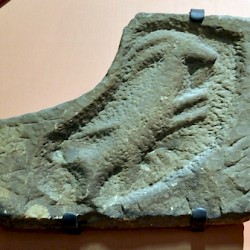 Hadrian's Wall, Capricorn of II Augusta |
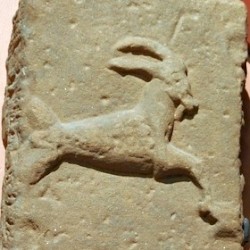 Castlesteads, Emblems of II Augusta: Capricorn and Pegasus |
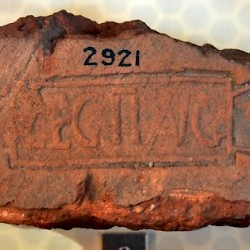 Chesters, Rooftile of II Augusta |
 Mainz, Tombstone of G. Julius Niger |
Related
- M. Hassall, "Legionary fortresses in Britain", in: Yann Le Bohec, Les légions de Rome sous le Haut-Empire (2000 Lyon) 441-457
- M. Hassall, "Pre-Hadrianic Legionary Dispositions in Britain", in: Richard J Brewer (ed.), Roman Fortresses and their Legions. Papers in honour of George C Boon (2000)
- L. Keppie, "Legiones Britanniae. Legiones II Augusta, VI Victrix, IX Hispana, XX Valeria Victrix", in: Yann Le Bohec, Les légions de Rome sous le Haut-Empire (2000 Lyon) 25-37
- article by Emile Ritterling

